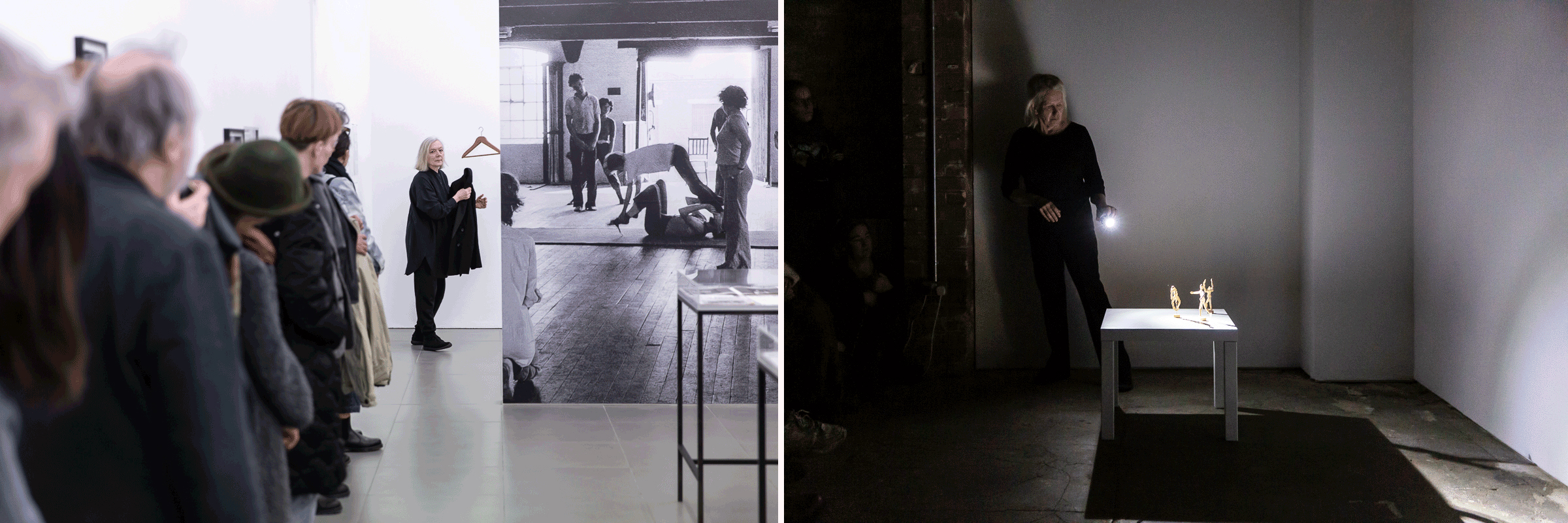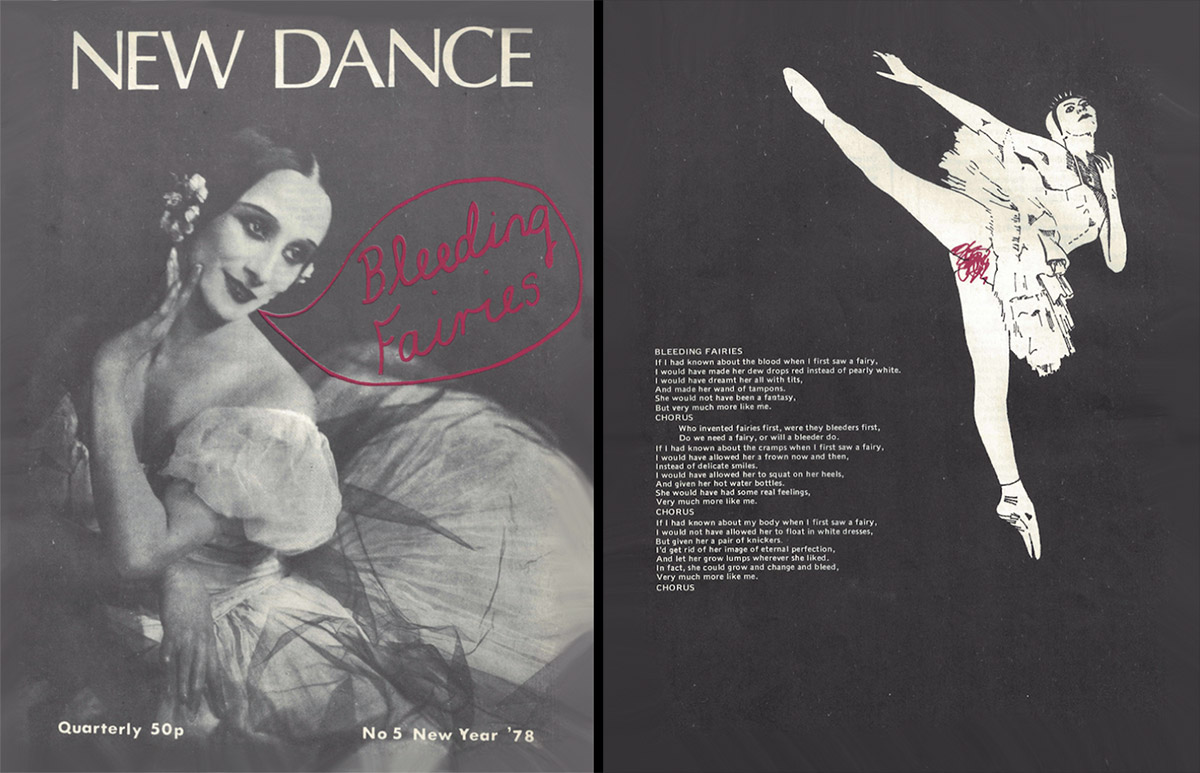JACKY LANSLEY'S BLOG

Jacky Lansley and Mary Prestidge performing as part of 'What Now' (2020) - an afternoon of new performances by members of X6 Collective for the exhibition ‘X6 Dance Space (1976-80): Liberation Notes’, images courtesy of Cell Project Space, photograph by Rob Harris
Throughout the first half of this year, 2021, I have been zoom meeting with my long time friend and colleague Mary Prestidge. Mary and I forged our relationship as founder members of the radical X6 Dance Space in the 70s; it was a pivotal moment for all the X6 collective* and generally for dance in the UK, as X6 became part of a growing movement of alternative dance practice identified as New Dance* and Independent Dance.
While Mary and I have had significant gaps in our contact over the last four decades, these early years created a lasting bond, which was celebrated in 2020 when we re-united to curate an archive exhibition of the X6 Dance Space works and publications at Cell Gallery in East London.* Since then Mary and I have continued the important conversations that emerged as part of the exhibition, including questions about why there is a continuing lack of context for New/Independent Dance performance in the UK. We both feel there is a danger that progressive dance languages will be lost and it is therefore really important to track and archive the generations of ground breaking work since the 1970s.
I have always held onto the word dance when identifying my performance, film and writing work, even where there is minimal dance involved and the work may seem more visual or conceptual. I am always optimistic that one can expand the expectations of what dance is and can be. Both Mary and I seem disappointed that the promise of new/experimental/independent dance has not flourished in the UK as it has (or did) in the US and to some extent in other parts of Europe. There are so many layers as to why this might be, not least the impact of conservative and neoliberal governments that have culturally locked in the UK since the 80s and Thatcherism. We would all be very naive if we did not understand both the explicit and subtle ways in which alternative art forms - and people - are shut down and made invisible by the conservative agenda.
Many in the UK dance scene, including areas of ‘modern’ dance, still seem to crave the stage of The Royal Opera House - or any opera house - as an ultimate goal or model of success. This determination to hold on to an elitist ballet platform reveals a deep conservatism and, I believe, a fear that dance as an art form is so fragile that it could slip back into being a mere support act. The artistic quality and substance of much of the high profile ballet based dance work we see, I think, is very questionable. As a choreographer I am frustrated by the constant display of athleticism and technique - dancers need technique and athleticism, but we don’t need to see it all the time - by the lack of stillness and breath and the frustrating lack of structure, image and concept in ballet choreography; in fact quite basic artistic elements that we expect from film, theatre, literature and visual/performance art. Even where there is some artistic substance and innovation, it is usually completely spoilt by the point shoe aesthetic. The assumption that the point shoe, divorced from its history and ethos, can somehow blend and integrate into a relevant and modern aesthetic, is, I think, absurd (though I have seen the point shoe used and framed well as part of conceptual/playful performance art, to good effect). The strictly held line of the point shoe in ballet is actually a denial of the body, particularly the female body and is a technique that is acquired at great physical cost. Ballet companies seem compelled to commission highly theatrical, over produced story ballets which serve to frame and display the point shoe and the virtuosity of the dancers; rich and ambitious productions often disguise the lack of artistic quality in both the performance and choreography.

“X6 Dance Space (1976–80): Liberation Notes” (2020), Cell Project Space, photograph by Rob Harris
In the UK we have no visible, established contemporary dance companies, let alone experimental, post modern dance. We need some infrastructure and real economic support for New/Contemporary dance which will involve solo artists, small experimental companies and perhaps even mid scale repertory companies. If there is no change, ballet will continue to dominate training and the art form; and the institutions which revere and support ballet will continue to absorb just enough elements from contemporary, even experimental work, which make them appear creative and relevant, when actually they are standing still. I borrowed this quote from Doris Humphrey * in my book 'Choreographies: Tracing the Materials of an Ephemeral Art Form’ (Intellect Books, 2017). It was written in 1958 but it could have been written now:
“I think all the branches of the proliferating tree should be examined with the heart, brains and conscience of caretakers and this includes the public, the choreographers, the business management, the dancers, students, teachers, government officials - in short, everybody who has even a passing interest in the art. And if these people individually, collectively, or both - refuse to grow up, think in the present and make of the dance a living thing, our times are going to seem to history like a prolonged infancy, or a twiddling of nineteenth-century toes while the present turns to ashes.”*
Some argue that it is a kind of privilege to be able to reject ballet when one has had the opportunity to have a ballet training - as I have done. I think this is a complex discussion, that needs more space than this blog. It is true that many will never have that opportunity, which is very sad - all children and adults should be able to study all kinds of dance forms - for their mental/physical health, wellbeing and shared joy with others. Also - I am certainly not advocating an either or situation - it should not be ballet OR contemporary/independent dance - we need it all! However at the present time in the UK it is a fact that the major companies which are still primarily driven by a ballet ethos and practice, receive most of the funding to this art form.
X6 Dance Space attempted to bring dance into the real world and liberate it as a vibrant art form. We were inspired by the concept and practice of The Thinking Dancer and The Thinking Body.* We expanded our technical and physiological knowledge of the whole body, as we embraced Body Mind Centering* work and the art of improvisation. Some of us studied Butoh, martial arts, Tai Chi, yoga and meditation towards a more holistic and profound knowledge of our bodies both inside and out and towards a practice of the fully present performer/dancer. We learnt to let the body release into gravity, using our weight - rather than hiding our weight - to create momentum and movement. Some of us expanded our dance work into visual and performance art, drawing on conceptual, visual and structural strategies to develop our choreographic and performance work. This expansiveness in our approach and methodologies gave us the tools to tackle important emotional and political issues in our practice and teaching and to find the forms which would allow this to happen. It also enabled us to work across different disciplines and within many different contexts, spaces and communities.
In more recent years Mary and I both founded open research studios, mine in London* and Mary’s in Liverpool,* which we continue to manage and direct alongside our own creative practice. The studios support many different independent artists and activities and have become part of a growing and important independent network, which has been particularly relevant during the pandemic. In a way we are continuing the legacy of X6 Dance Space and its focus on unlocking dance so that it can contribute to finding solutions to the major global problems we all now have to confront.
Jacky Lansley, June 2021
Footnotes:
*X6 Collective: Mary Prestidge, Fergus Early, Meadee Dupres, Emilyn Claid and Jacky Lansley.
*New Dance (New Dance Movement): initiated by the X6 Collective who founded the seminal X6 Dance Space. A key aim was to view and explore dance within a wider social context and to enable diverse participants to engage in community, educational and professional dance activity. New Dance Magazine, produced by the X6 Collective, was a voice for New Dance from 1977-1988.
*Cell Project Space, in Hackney London, is a non-profit gallery and artist studios founded in 1999.
*Doris Humphrey (1895-1958): American dancer and choreographer who was one of the second generation modern dance pioneers who followed forerunners Isadora Duncan, Ruth St Denis and Ted Shawn.
*Doris Humphrey: ‘The Art of Making Dances’ (New York: Holt, Rinehart and Winston, 1959). ‘Conclusion’ 167-176 (176).
*The Thinking Body by Mabel Elsworth Todd (p.1937). A classic study of physiology and the effect of psychological processes on movement that has a mind/body approach.
*Bonnie Bainbridge Cohen, movement artist, therapist, educator and researcher is the developer of the Body- Mind Centering approach to movement and consciousness.
*Dance Research Studio is an independent research centre for innovative dance and performance founded by Jacky Lansley in 2002. Situated in Shoreditch in central London, the studio provides an accessible and nurturing laboratory for combined arts research and development.
*LIC Studio is the first designated artist led space for dancers in Liverpool. Founded by the Liverpool Improvisation Collective (LIC) Mary Prestidge, Andrea Buckley, Paula Hampson and JoBlowers at the Bluecoat Arts Centre in 2008.